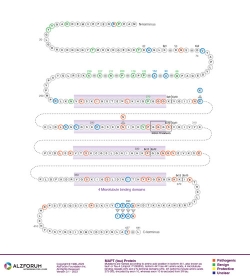Mutations
MAPT E372G
Quick Links
Overview
Pathogenicity: Frontotemporal Dementia : Pathogenic
Clinical
Phenotype: Frontotemporal Dementia
Position: Chr17:44101326 A>G
dbSNP ID: NA
Coding/Non-Coding: Coding
DNA
Change: Substitution
Expected RNA
Consequence: Substitution
Expected Protein
Consequence: Missense
Codon
Change: GAA to GGA
Reference
Isoform: Tau Isoform Tau-F (441 aa)
Genomic
Region: Exon 13
Findings
This mutation was discovered in a patient who presented with signs of behavioral variant frontotemporal dementia at age 40. As his disease progressed, he developed memory deficits, agrammatic speech, and parkinsonism, and exhibited signs of pyramidal tract dysfunction. Imaging studies revealed atrophy of the frontal and temporal lobes and reduced metabolic activity in the frontal lobes. He died at age 58.
A paternal uncle was also reported to suffer from early onset dementia. However, DNA was not available from family members, so it was not possible to determine whether the mutation segregates with disease in this family. This mutation was not found in 1,224 healthy controls, or in the 1,000 Genomes, Exome Variant Server, or HEX databases.
The data currently available suggest that this mutation is pathogenic.
Neuropathology
Gross examination of the patient’s brain at autopsy confirmed atrophy of the frontal and temporal lobes, and further revealed atrophy of the hippocampus and amygdala. Additional changes included enlargement of the lateral ventricles, thinning of the corpus callosum, and decreased pigmentation of the substantia nigra and locus coeruleus.
Microscopic examination revealed gliosis, neuron loss in the hippocampus and substantia nigra, and evidence of corticospinal tract degeneration.
Tau immunohistochemistry showed Pick body-like neuronal inclusions and swollen, tapering, thread-like processes in white matter. Both of these features were more strongly immunoreactive for three-repeat than for four-repeat tau. The white-matter threads, but not the Pick-like inclusions, were Gallyas-positive. Further examination of the thread-like processes, using immuno-electron microscopy, showed that they were unmyelinated and packed with phospho-tau filaments; the filaments were mostly straight, but a few appeared as paired helical filaments. Most of the abnormal processes also contained vacuoles.
Biological Effect
The E372G mutation promoted tau filament formation in in vitro assays comparing recombinant mutant and wild-type tau proteins. The mutation also slightly diminished tau’s ability to promote microtubule assembly.
Last Updated: 05 Apr 2019
References
No Available References
Further Reading
No Available Further Reading
Protein Diagram
Primary Papers
- Tacik P, DeTure MA, Carlomagno Y, Lin WL, Murray ME, Baker MC, Josephs KA, Boeve BF, Wszolek ZK, Graff-Radford NR, Parisi JE, Petrucelli L, Rademakers R, Isaacson RS, Heilman KM, Petersen RC, Dickson DW, Kouri N. FTDP-17 with Pick body-like inclusions associated with a novel tau mutation, p.E372G. Brain Pathol. 2016 Oct 5; PubMed.
Alzpedia
Disclaimer: Alzforum does not provide medical advice. The Content is for informational, educational, research and reference purposes only and is not intended to substitute for professional medical advice, diagnosis or treatment. Always seek advice from a qualified physician or health care professional about any medical concern, and do not disregard professional medical advice because of anything you may read on Alzforum.


Comments
No Available Comments
Make a Comment
To make a comment you must login or register.